Gen. Lucius D. Clay paved the way for the Interstate Highway — here’s the story of the military hero who made America’s rubber meet the road
Master of logistics Gen. Lucius D. Clay supplied America’s army in World War II, then ran the Berlin Airlift, saving the people of West Berlin in the Cold War. President Eisenhower later tapped him to map a plan for the Interstate Highway System.
America's Interstate Highway System carries the lifeblood of the world's largest economy, essential to the daily lives of almost every citizen today.
It’s officially called the Dwight D. Eisenhower National System of Interstate and Defense Highways, in honor of the president who championed its creation.
But the commander-in-chief had a secret weapon when it came time to make the rubber meet the road.
His name was Lucius D. Clay.
He was a retired general who served under and beside Eisenhower in World War II.
Clay was a legendary master of organization, management and military logistics, by all accounts. He provided the food, clothes and firepower that Ike and American GIs needed to crush into dust Hitler's once-unstoppable war machine.
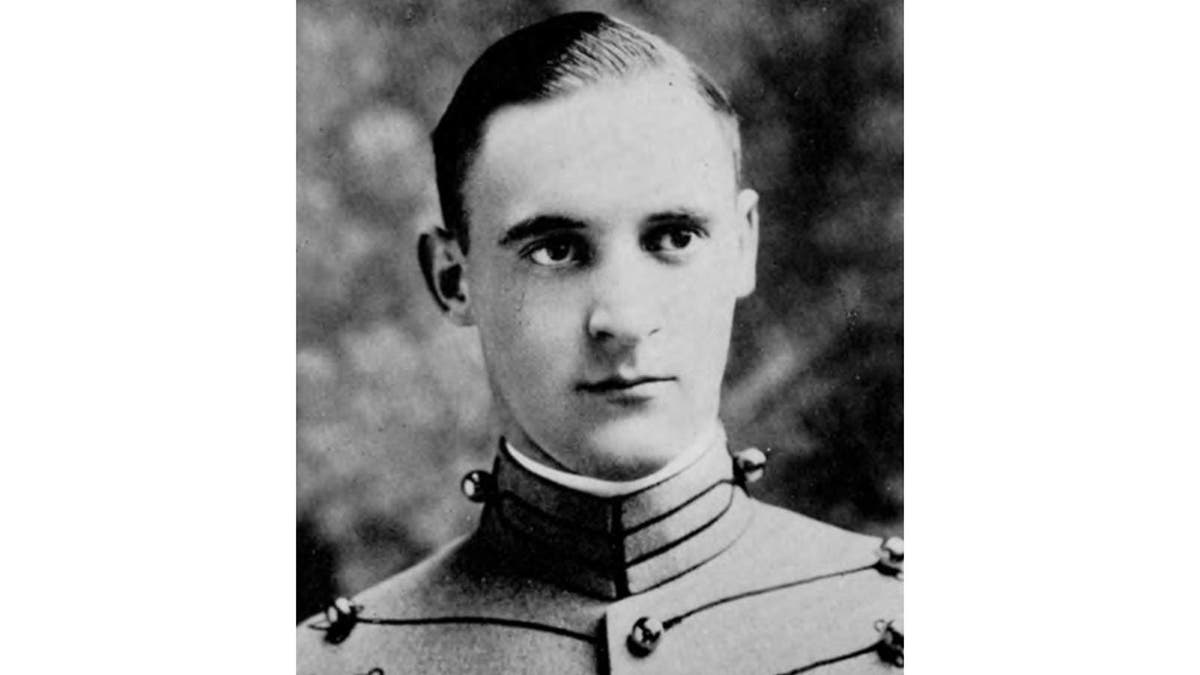
Portrait of Lucius Dubignon Clay (1898–1978) at West Point in 1918 from "The Howitzer: The Yearbook of the United States Corps of Cadets," 1919, page 83. (Public Domain)
He was Eisenhower's pick in the 1950s to plan the sprawling 49,000-mile transportation system that was, and is, the largest and most ambitious engineering project in human history.
"Lucius Clay represents a fiery type of fellow that you see in old-fashioned movies like ‘Gone With the Wind,’" former Secretary of Defense Robert A. Lovett said, as quoted by Jean Edward Smith in his 1990 biography, "Lucius D. Clay: An American Life."
"Lucius Clay represents a fiery type of fellow that you see in old-fashioned movies." — Robert A. Lovett
"He’s the kind of military leader the Confederate Army produced in goodly numbers. They were proud people. They weren’t wild entirely, but they weren’t afraid of anything."
Clay managed the greatest supply chain in world history as chief procurement officer for the U.S. Army in Europe in World War II.

Sign for the Interstate Highway System, saluting President Dwight Eisenhower, who initiated the system in the 1950s. (Carol M. Highsmith/Buyenlarge/Getty Images)
When that Army threatened to outpace its supplies in the days after D-Day, Clay was called into undo the snafu and reopen the devastated French port of Cherbourg.
After the war, Clay organized the Berlin Airlift — an incessant skytrain of supplies that saved the people of West Berlin and made him a hero in two nations.
He then paved the way for the sprawling interstate, which boosted the national economy and helped make the open road a metaphor for American freedom.

Traffic moving along Interstates 5 and 90 through downtown Seattle is viewed in a time exposure photo at dusk on Nov. 3, 2015, in Seattle, Washington. (George Rose/Getty Images)
Gen. Clay, most simply, executed for the United States complex plans of ungodly scope and unprecedented ambition.
‘Hero would never be forgotten’
Lucius Dubignon Clay was born on April 23, 1898, in Marietta, Georgia to Alexander and Sara Frances (White) Clay.
It was a politically prominent family. Alexander represented Georgia in the U.S. Senate from 1897 until 1910.
He died in office when the future general was just 12 years old.
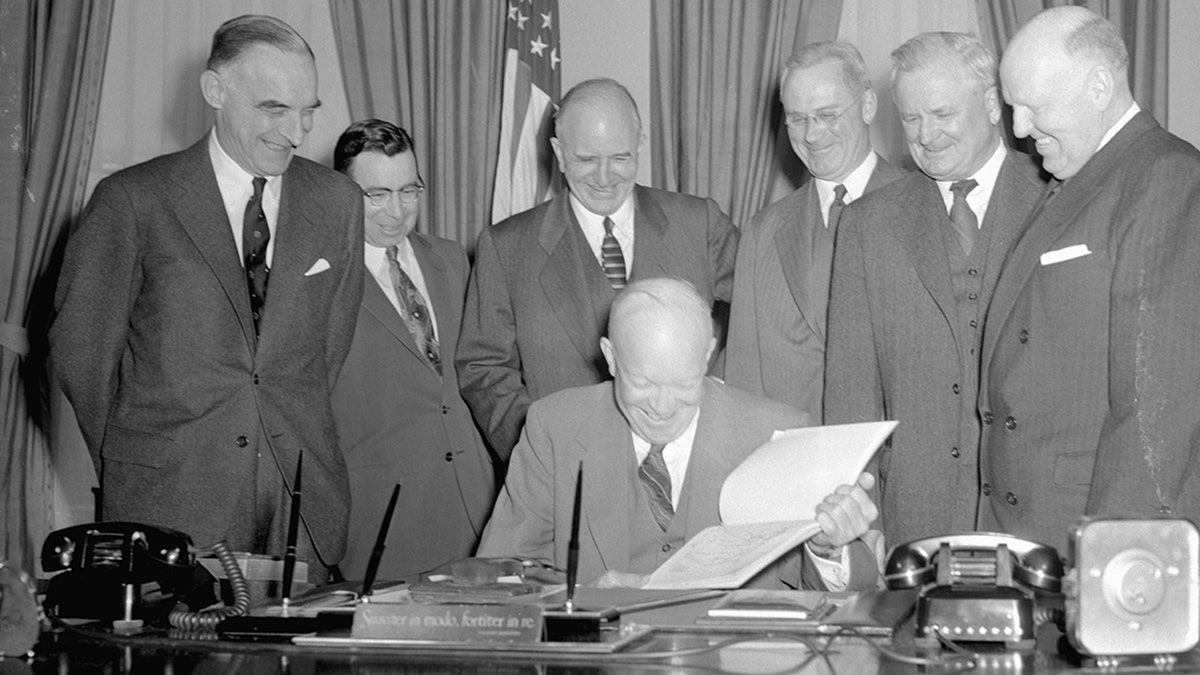
Members of the president's advisory committee on national highways are shown as they presented President Eisenhower with recommendations. Left to right, behind Eisenhower: Gen. Lucius D. Clay, chairman; Frank C. Turner, executive secretary; Stephen D. Bechtel of San Francisco; S. Sloan Colt of New York City; William A. Roberts of Milwaukee; and David Beck, president of the International Brotherhood of Teamsters. (Getty Images)
"Forced into tough financial straits by the death of his father, Clay managed to escape the alcoholism that claimed his five older siblings," PBS American Experience wrote in a Clay biography.
He found his future at West Point, graduating as a military engineer at age 20 in 1918. It appears taking orders was not his forte.
MEET THE AMERICAN WHO INVENTED THE MOTOR HOME
"His academic standing was 27th in a class of 137, but his discipline record was another matter," Richard F. Weingroff wrote in a detailed history of the interstate for the Federal Highway Administration.
He quickly proved himself in the real world, deftly managing major engineering and construction projects around the nation.
"At the start of World War II, Clay was assigned to manage crash construction of 500 airfields," writes Weingroff.
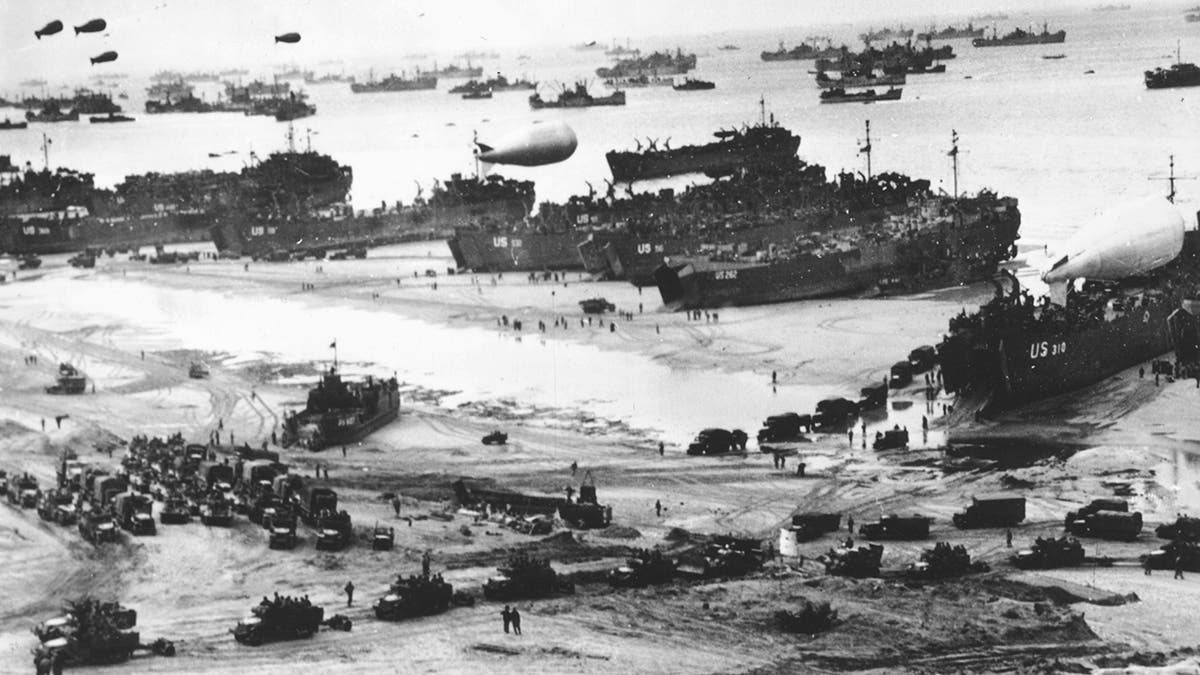
14th July 1944: Fleets of U.S. transport and landing craft disgorge reinforcements and supplies for the US troops who liberated the Contentin peninsula, the deep-water port of Cherbourg and the communication center of La Haye du Puits. Barrage balloons float overhead as protection against German strafing airplanes, which did not appear. (Keystone/Hulton Archive/Getty Images)
His success earned him a promotion to brigadier general at age 43, the youngest officer to reach that rank in World War II.
He became Eisenhower's chief procurement officer in Europe in 1942. His job was simple: Ensure that the most powerful Army ever assembled was fed, clothed, armed and victorious.
"Forced into tough financial straits by the death of his father, Clay managed to escape the alcoholism that claimed his five older siblings."
"He procured 299 million pairs of pants, 50 million field jackets, 2.3 million trucks, 178,000 artillery pieces, 88,000 tanks, and billions of rounds of ammunition," writes Weingroff.
He replaced Eisenhower as military governor of Germany in 1947. It was another job of intense complexity.
It pitted the humanitarian needs of the ruined nation with the growing geopolitical standoff against the Soviet Union.
"Clay got to know his Soviet counterparts during meetings of the Allied Control Council in Berlin and became convinced that the city must not be abandoned to communist dominance," PBS' "American Experience" writes in a history of the Berlin Airlift.
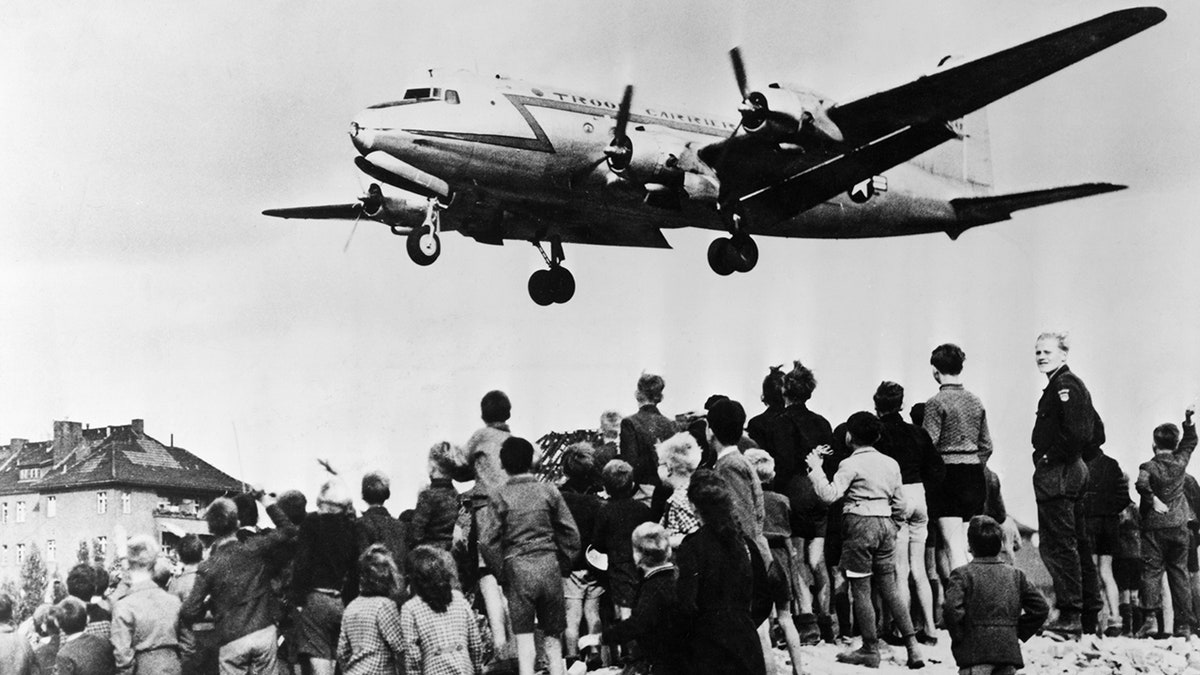
In 1948-49, Berlin, Germany: The Berlin airlift brings supplies to the blockaded city of 2½ million West Berliners. Children eagerly wait for the plane. (Getty Images)
The feud came to a head in June 1948, when the Soviets shut down all ground transport into West Berlin, an island of budding democracy surrounded by communist-controlled East Germany.
"Suddenly, some 2.5 million civilians had no access to food, medicine, fuel, electricity and other basic goods," writes History.com.
Clay had already hatched a plan to supply West Berlin by air. It proved one of the great logistical success stories in human history.
MINNESOTA PASTOR'S VIRAL POST ABOUT PEOPLE DRINKING COFFEE IN CHURCH IGNITES FIERY DEBATE
The Berlin Airlift delivered 2.3 million tons of supplies with 278,000 flights from June 1948 to September 1949 — more than 25 flights an hour every hour for 15 months.
Clay retired from military service with the end of the blockade on May 12, though the airlift continued for four more months.
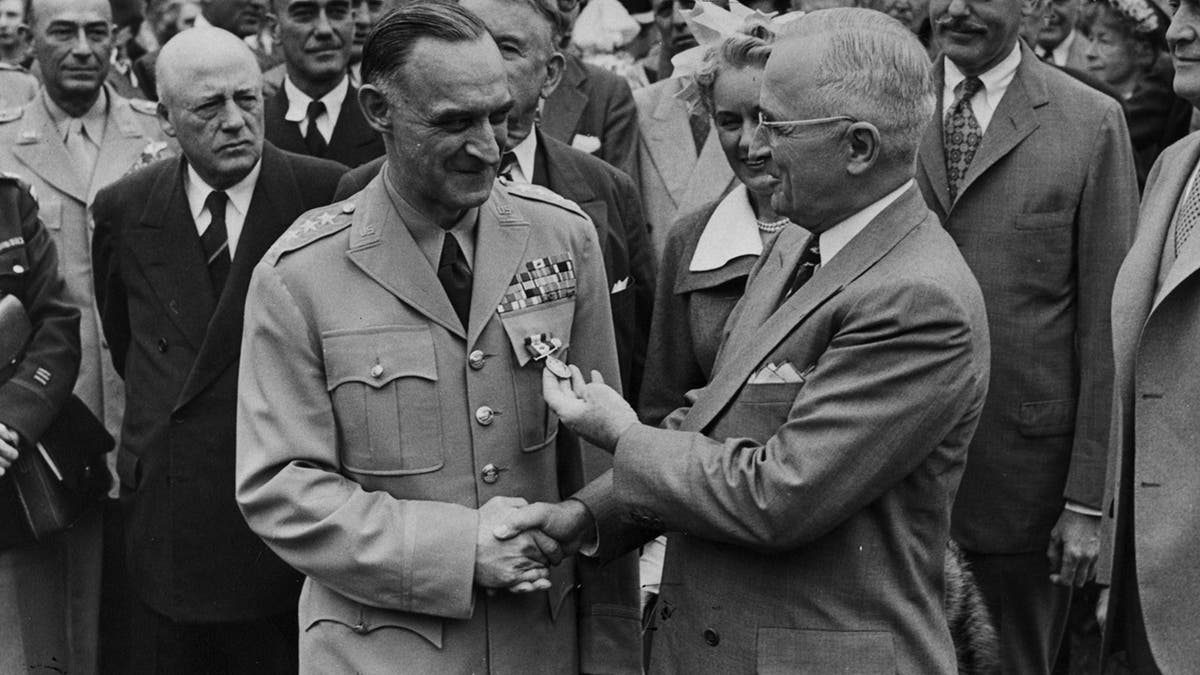
In 1948, President Harry S. Truman (1884-1972) is shown awarding American General Lucius Clay (1897-1978) with the Distinguished Service Medal for his role in the Berlin Airlift. (MPI/Getty Images)
Clay was "saluted as a hero who would never be forgotten by Berlin Mayor Ernst Reuter," reports PBS' "American Experience."
He was also saluted as a hero by the American people.
Clay was welcomed back to the United States with a ticker tape parade down Broadway's famous "Canyon of Heroes" in New York City on May 19, 1949.
‘Wisdom of broader ribbons'
President Eisenhower was famously inspired to champion the interstate highway by two major life events.
The young officer traveled across the United States with an army convoy from Washington, D.C., to San Francisco in 1919.
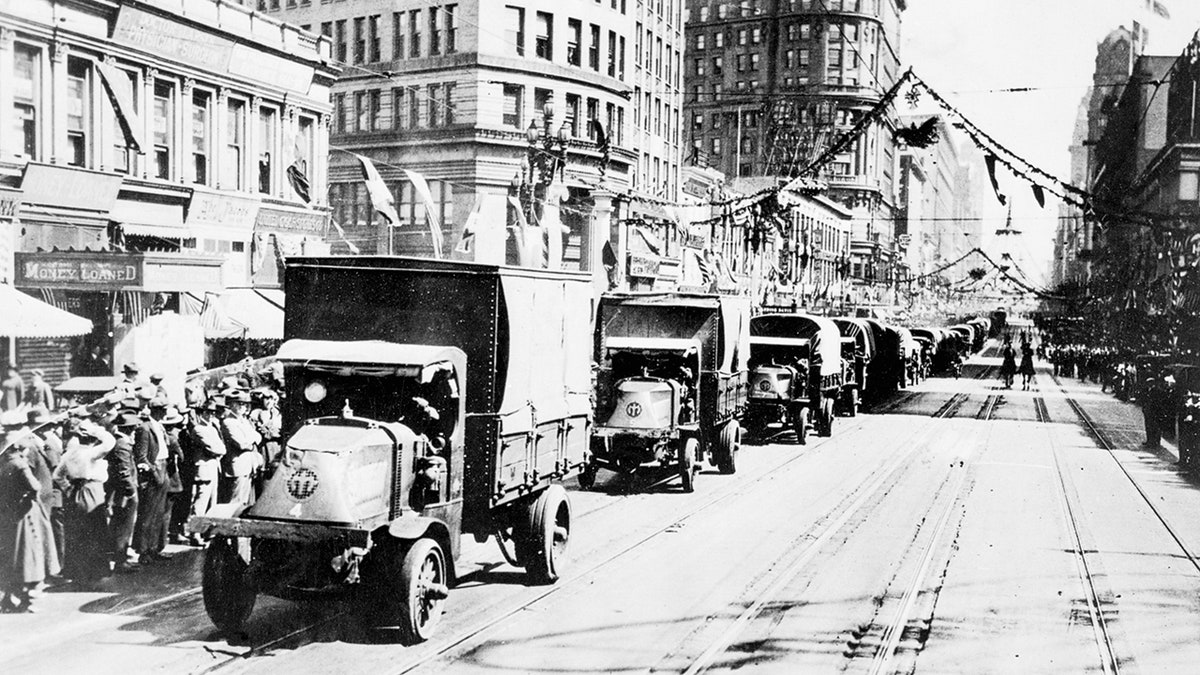
The U.S. Army tested the feasibility of moving men and equipment across the country in 1919. Lieutenant Colonel Charles W. McClure, Army Motor Transport Corps, led 65 trucks and other vehicles, for total of 72, and 300 troops, from Washington, D.C., to San Francisco starting July 7. The trip took 62 days. (HUM Images/Universal Images Group via Getty Images)
The trip took 62 days, a perilous journey down roads that were often poor, narrow and unpaved.
The second turning point in Ike’s road to the interstate came in 1945, as Nazi forces crumbled against the onslaught of American might – much of it brought to the battlefield by Clay.
"Germany had made me see the wisdom of broader ribbons across the land." — Dwight Eisenhower
American GIs marveled as they thundered into the heart of Germany with unprecedented speed along its magnificent autobahn.
"The old convoy had started me thinking about good, two-lane highways," wrote Eisenhower years later.
"But Germany had made me see the wisdom of broader ribbons across the land."
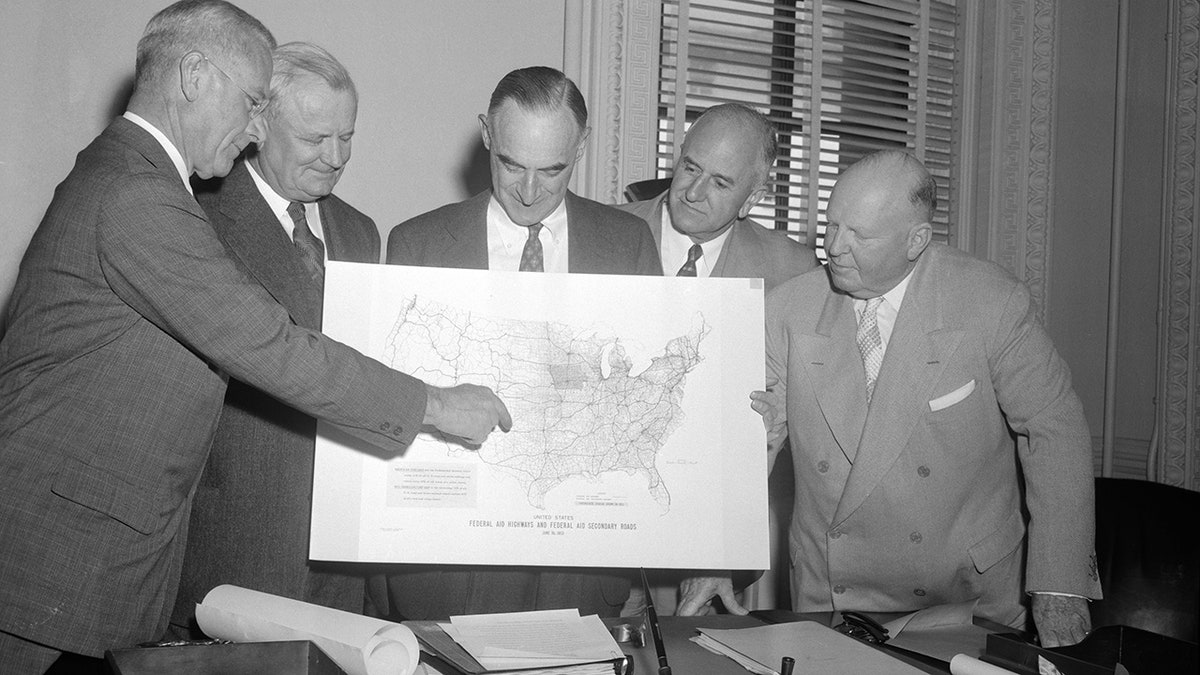
Members of a presidential committee began a conference with business and industrial leaders to map plans for carrying out President Eisenhower's highway construction program. From left: S. Sloan Colt, president of Bankers Trust Company; William A. Roberts, president of Allis Chalmers Company; General Lucius D. Clay, chair of the president's committee on the National Highway Program; Stephen Bechtel, president of the Bechtel Corporation; and David Beck, president of the International Brotherhood of Teamsters. (Getty Images)
The creation of the interstate became one of his top priorities in 1954, following the end of the Korean War.
Eisenhower created the President's Advisory Committee on a National Highway Program in 1954.
"Sherman Adams, the president's chief assistant, asked who should serve on the committee," writes Weingroff.
"The president said, ‘Call General Clay.’"
Clay organized a committee of the best and brightest business and construction minds in the United States, tasked with bringing to the White House and to Capitol Hill a plan to fund and build a network of high-speed roads that would unite the nation from sea to shining sea.
Eisenhower signed the Federal Aid Highway Act of 1956 on June 29, 1956.
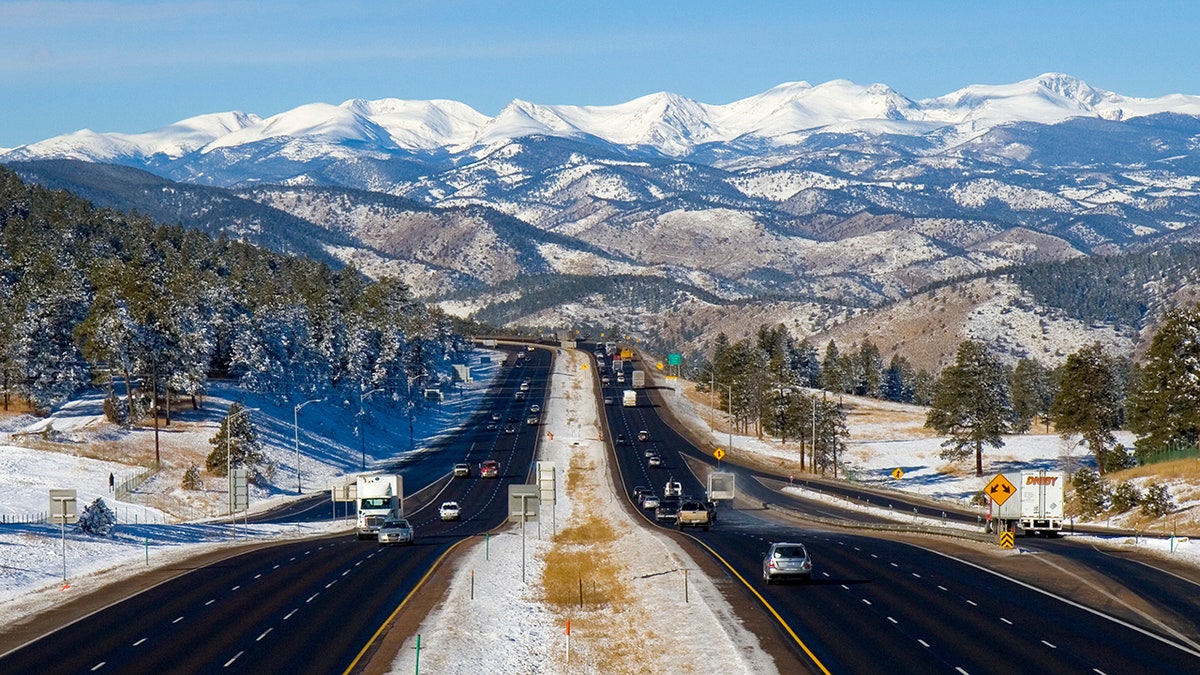
Snow covers the landscape surrounding Interstate 75 near Denver, Colorado, facing west toward the Rocky Mountains. (Tony Savino/Corbis via Getty Images)
The first shovels to build the interstate hit the dirt near St. Louis, Missouri, on Aug. 13, 1956, now the Mark Twain Expressway stretch of Interstate 70.
The 2,200-mile highway connects Baltimore, Maryland, to the mountain community of Cove Fort, Utah, about 5,000 feet above sea level.
Congress, the White House and Clay himself battled over his committee's original plan in the typically contentious Washington, D.C., process.
The first shovels to build the interstate hit the dirt near St. Louis, Missouri on August 13, 1956.
The "highly regulated" interstate that emerged features lanes 12 feet wide, shoulders 10 feet wide, bridges of minimum 14 feet, grades of less than 30, and limited access, with an average of only one interchange every 2.5 miles — all of it designed for vehicles to move 70 miles per hour, David A. Pfeiffer reported for Prologue Magazine of the National Archives in 2006.
The American people, and American business, turned the interstate into the busiest road network in the world and a conduit of incredible economic growth.
Smaller, faster, wealthier, freer, more agile nation
Lucius D. Clay died on April 16, 1978, of heart failure in Chatham, Massachusetts, on Cape Cod. He was 79 years old.
He was survived by his wife, Marjorie McKeown, and sons U.S. Air Force Gen. Lucius D. Clay, Jr., and U.S. Army Major General Frank B. Clay.
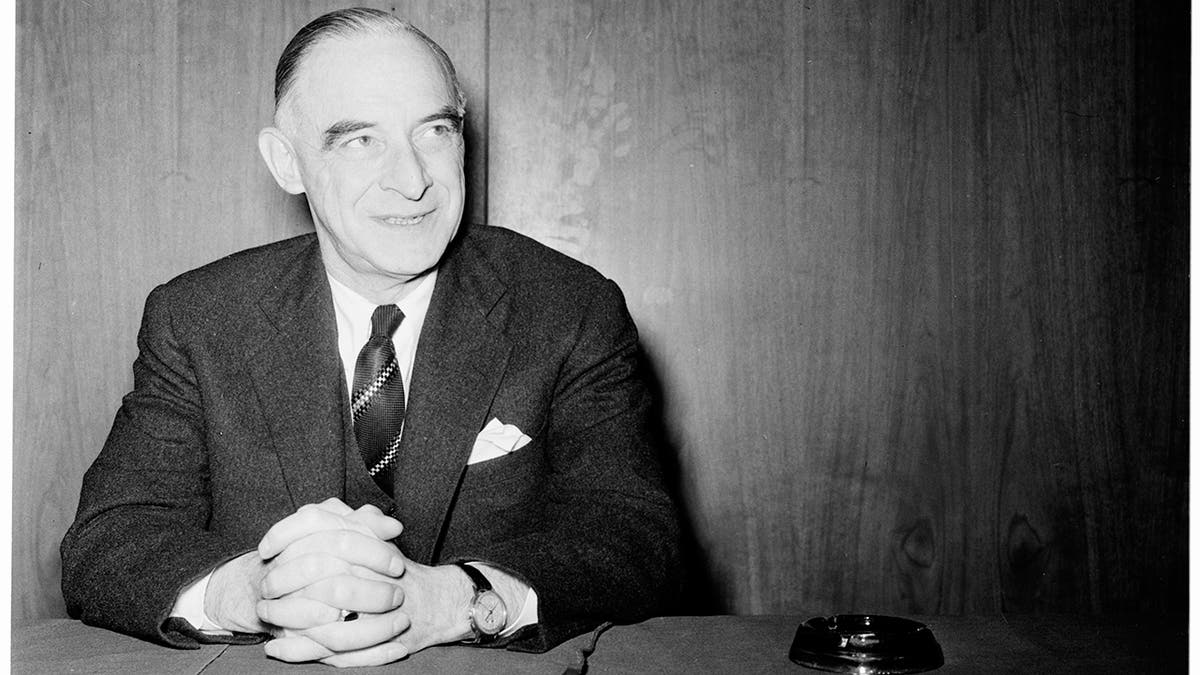
Retired General Lucius D. Clay, national chairman of the Red Cross fund drive, Feb. 20, 1958. (Lou Mack, Los Angeles Examiner/USC Libraries/Corbis via Getty Images)
Both sons enjoyed their own distinguished military careers.
Gen. Clay Jr. even served as commander in chief of the North American Air Defense Command (NORAD) in the 1970s.
The elder Gen. Clay was buried at West Point. He is celebrated today at both his alma mater and in Germany for his role in preventing the spread of communism.
"A Berlin street bears Clay's name, and a memorial from its citizens at his West Point grave salutes the ‘defender of our Freedom,’" reports PBS.
"The federal Republic [the former West Germany] is largely the story of the courage and persistence of this remarkable man," said John J. McCloy, his successor of military governor of Germany.
Clay served on more than a dozen corporate boards in civilian life. Among them, he was the longtime chairman of the board of Radio Free Europe, which fed western news to communist-controlled Eastern Bloc nations.
He was an adviser to President John F. Kennedy in the 1960s.
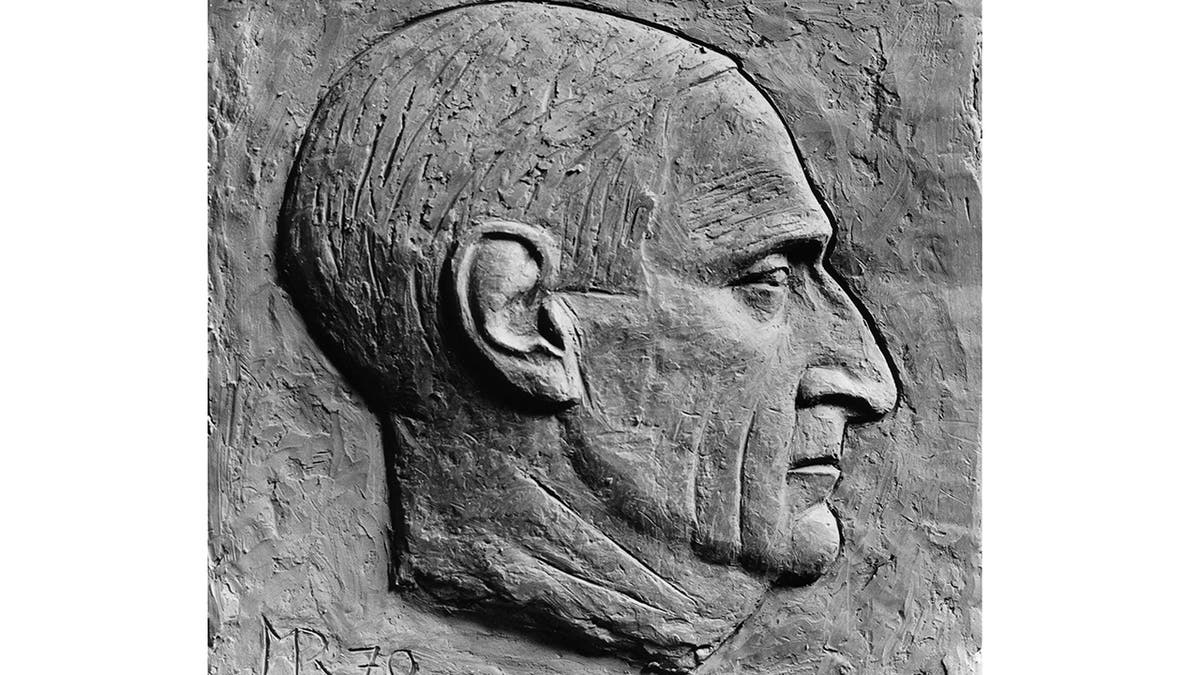
A relief of Gen. Lucius Clay in Berlin, Germany, in honor of his time as military governor of the nation after World War II and his effort to save the city's people during the Berlin Airlift. (Waldthausen/ullstein bild via Getty Images)
Clay’s life was one of such distinction and accomplishment that his role in creating the world’s most vital road network merited only passing mention.
CLICK HERE TO SIGN UP FOR OUR LIFESTYLE NEWSLETTER
It’s the one accomplishment, however, that impacts the lives of every American every single day.
The United States has 4.2 million miles of road, the largest network in the world and more than 10% of the global total.
"General Clay could run anything. General Motors or General Eisenhower's Army." — attributed to James Byrnes
The Interstate comprises little more than 1% of US roadway miles.
But it carries 25% of all auto traffic and 50% of truck traffic, according to various industry estimates.
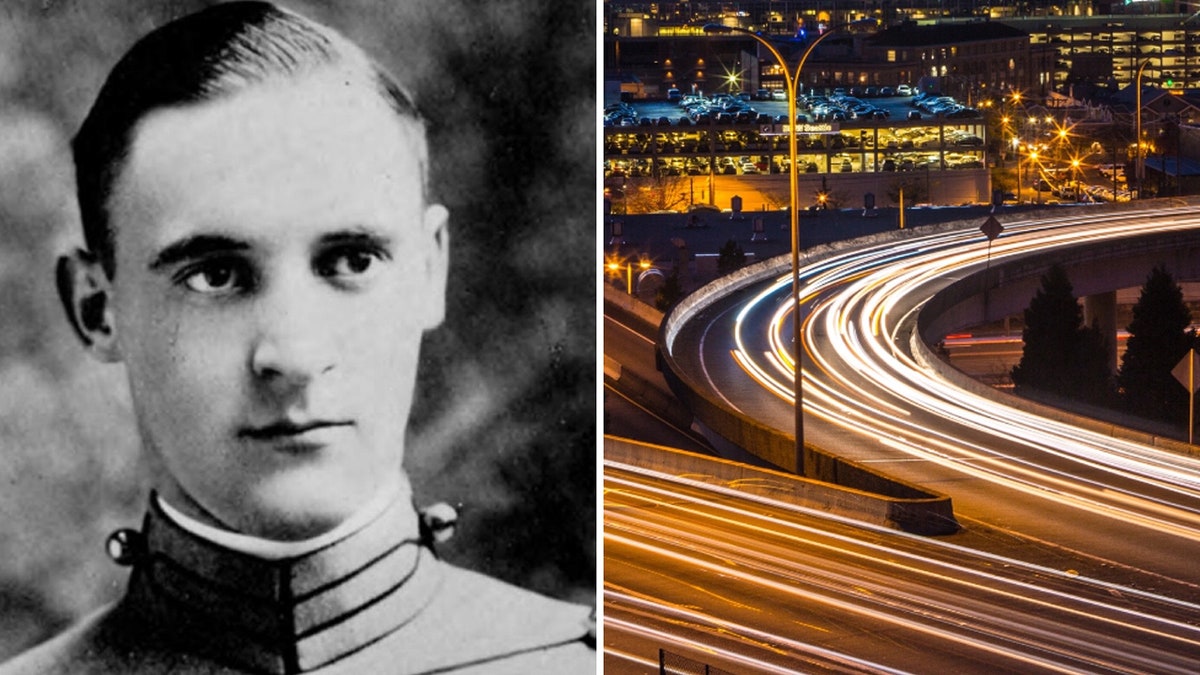
Gen. Lucius Clay was a World War II master of logistics who created the plan to make the dream of the Interstate Highway System a reality. (Public Domain; George Rose/Getty Images)
The interstate is the crown jewel of the American roadway — it made the United States smaller, faster, wealthier, freer and more agile.
CLICK HERE TO GET THE FOX NEWS APP
"General Clay could run anything," according to one apocryphal quote, often attributed to former Secretary of State James Byrnes.
"General Motors or General Eisenhower's Army."
To read more stories in this unique "Meet the American Who…" series from Fox News Digital, click here.
For more Lifestyle articles, visit www.foxnews.com/lifestyle.


